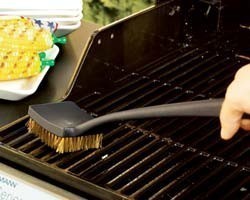Hey Y’all, Grill Girl Here. I’m right in the middle of fixing up this Barbecues Galore Turbo grill that’s about 15 or 20 years old and I wanted to give you a note about how to clean a gas grill.
Now, everyone has their own ideas *and of course you’re entitled to yours* but this is how I feel about gas grills; you should be able to leave them outside. They are outdoor cooking appliances and you shouldn’t have to thoroughly clean them every single time you use them.
When to Clean a Gas Grill
Think about your oven. Most people don’t scrub out their oven every single time they use it. Preheat your grill (get it really hot) each time you cook, before you put the food on it. This will sanitize the cooking space. It’s good to use a grid brush to remove food particles and debris from your cooking grid. However, you don’t have to constantly clean everything else to keep your grill in shape. In fact, grease drippings on the heat dispersal (the level that goes right above the burner) give you a better flavor.
That being said, once or twice a year, go through and clean all parts of your grill.
We recommend cleaning your grill at the end of your busiest grilling season, sometime in the fall, before you put it away for the winter. Remove the food and grease debris from your grill and avoid it being a magnet for rodents or insects. Also, it helps keep your grill parts in better shape while not in use.
It’s a good idea to clean it again when you take it back out in the spring. Sometimes spiders can build webs that impact the gas flow in burners and valves. Turn on each burner to make sure they light up all the way. Take this opportunity to check to see if there are any parts you need to replace.
If you cook all throughout the year, choose two times each year to clean your grill. We still think Fall and Spring work!
How to Clean a Gas Grill
You don’t want to get too much debris stuck down into the bottom of the grill body. It can be a cooking hazard and give you some burned flavor. For the twice-yearly cleaning, make sure your grill is completely cool. Remove the cooking grids and heat dispersal system (heat plates, briquettes, etc). Get on your gloves if you don’t want to your hands to get dirty. Use a firm-bristle plastic brush (as shown in the video) to brush out the debris in the body of the grill. Use a shop-vac or small dustpan to remove it.
It’s amazing how much nicer your grill looks after that simple task.
While your cooking grids are out you can scrub them more thoroughly than your everyday cleaning. If you have a porcelain-coated grid, you’ll want to be careful not to chip it off. Use a brass-bristled brush or a sturdy non-scratch scrub pad for the job.
Use the plastic brush you used in your grill on your heat dispersal to clean it off a little bit. Remember that heat dispersal gives your grill a smokey flavor so don’t spend too much time on it.
If you have a cast burner (iron, stainless steel or brass), clean out the holes of the burner with a toothpick or straightened-out paper clip. Remove the burner to do this well. If you’re having trouble lifting it up and out of the grill, it’s probably anchored in by a hitch pin at the back of the grill.
Put the parts all back in and your grill should be good to cook again.
Sometimes my customers tell me that they spend 20 or 30 minutes after every time they cook to clean their grill. To me, it’s just not the point of a gas grill. You know? It’s going to get a little dirty and that’s ok.








